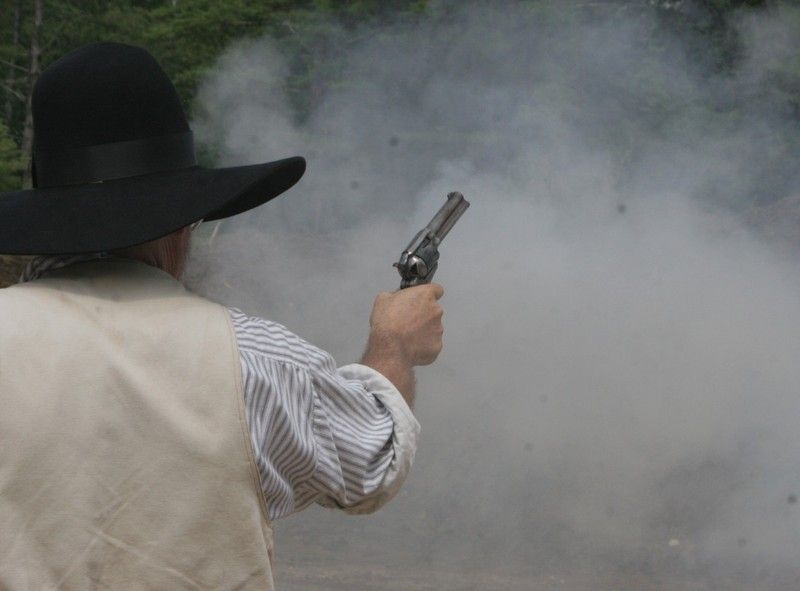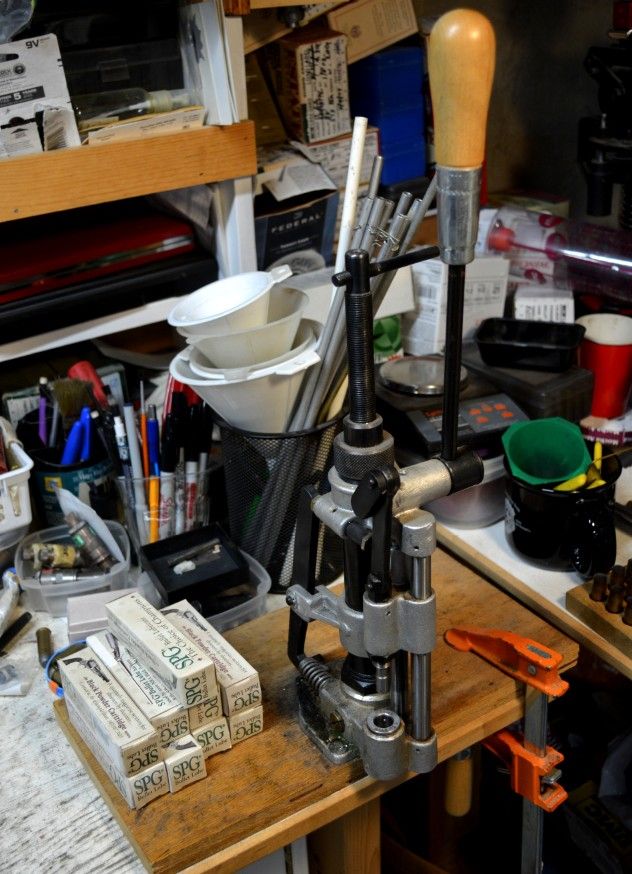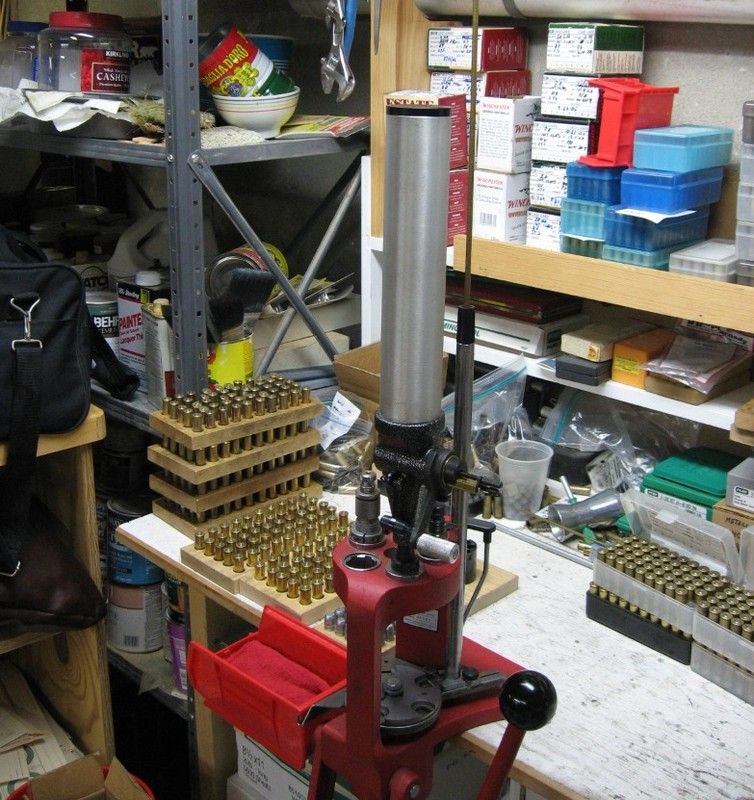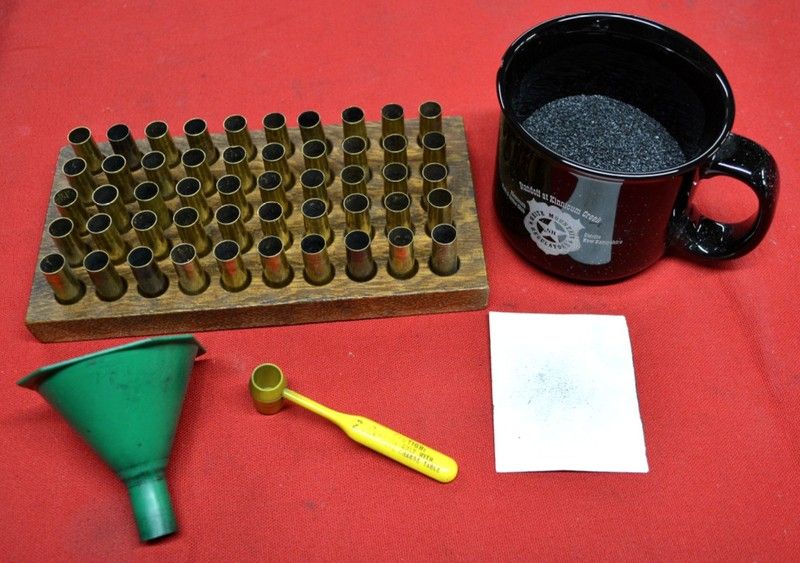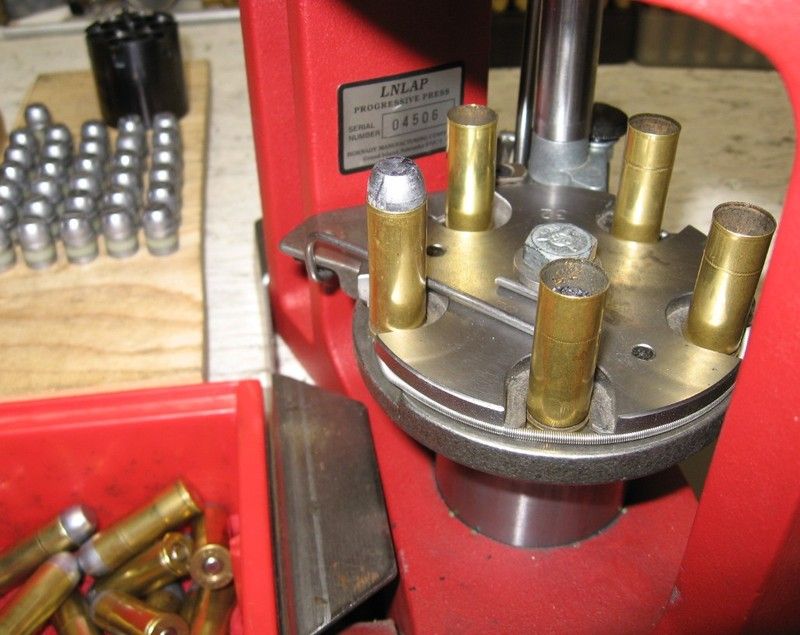Driftwood Johnson
New member
Howdy
I have must have loaded a bazillion cartridges with Black Powder for Cowboy Action over the years, 45 Colt, 45 Schofield, 44-40, and 38-40.
You don't have to look up a recipe for loading Black Powder in cartridges. All you have to do is pour in enough powder so that when the bullet is seated it will compress the powder by about 1/16" - 1/8". That's all there is to it.
Although I must confess I have never loaded 357 Mag or 38 Special with BP, the idea is the same.
The Snakebite Greasewagon Big Lube bullet was developed specifically so that when crimped in the crimp groove of a 38 Special round the OAL will be close to the OAL of a 357 Magnum.
Here is a photo of a Snakebite (yes, I have a whole bunch for when I ever decide to load up some 38s with BP) with the crimp groove lined up with a 38 Special case on the left and a 357 Mag case on the right.
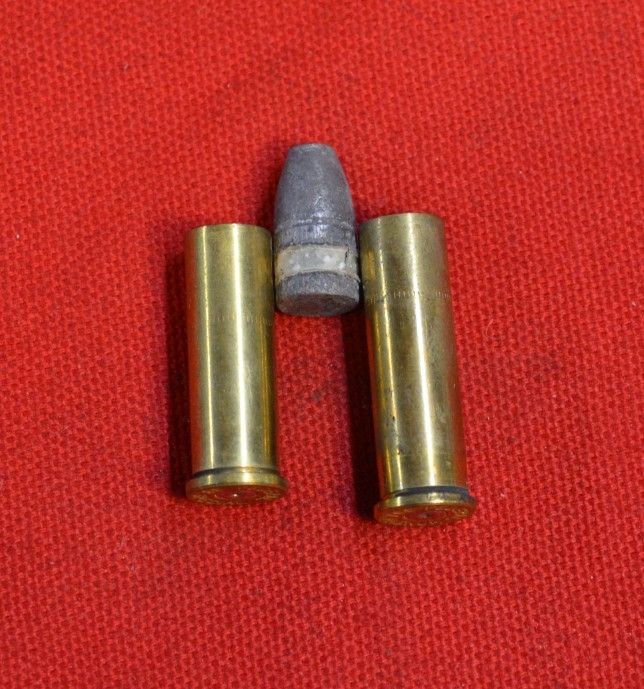
When crimped in the crimp groove, the Snakebite bullet will result in an overall length of about 1.550 in a 38 Special case. Just about Max OAL for a 38 Special.
When crimped in the crimp groove, the Snakebite bullet will result in an overall length of about 1.670 in a 357 Mag case. My Lyman Cast Bullets handbook shows a Max OAL for 357 Mag as 1.590. This is probably too long for the cylinder of many revolvers and is probably too long for the carrier of an Uberti 1873 replica lever gun. Yup, just checked the carrier on my 44-40 Uberti '73. The carrier is about 1.620 long. All the Uberti rifles use the same length carrier, no matter what the caliber is. So the first time you try to lever the action with your '73 it will jam for sure with a 357 Mag round loaded with the Snakebite bullet.
The Big Lube family of bullets was designed specifically to hold enough soft BP compatible lube to keep the bore of a rifle lubed with soft bullet lube for its entire length, so hard fouling will not build up in the bore. You can often get away with less bullet lube for a revolver, but frankly all my revolvers keep rolling better with Big Lube bullets than they ever did with standard hard cast bullets pan lubed with a BP compatible bullet lube.
Here is the scoop on the Snakebite Greasewagon Big Lube bullet:
http://www.biglube.com/BulletMolds.aspx?ItemID=ee788c75-7068-4a70-a6f0-6d4ee38b0030
If you want to load BP in a 357 Mag case, you might want to try this bullet instead. Just an educated guess, I have never loaded any myself.
http://www.biglube.com/BulletMolds.aspx?ItemID=ebcdc217-f282-40a1-92ba-ca09fa487426
I do know a few guys who load 38 Specials with Black Powder, in the interest of full disclosure I am not exactly what bullet they use. But I think you will run into less OAL problems if you stay with 38 Specials rather than 357 Mags. Don't worry, you will still get plenty of Smoke and Boom.
Regarding dies, you can use any brand you want to load Black Powder. No different than loading Smokeless in that aspect.
I always load all my BP rounds with a standard roll crimp that is standard on most dies designed for cast bullets. Yes, you do want to full length resize, and yes you do want a nice strong crimp. With a repeater, either a revolver or a lever gun, the last thing you want is bullets jumping forward when the gun recoils. Single shots are a different story. You only load one at a time, so it does not matter if the bullet is not crimped.
P.S. If you want to try some bullets before investing in molds, you can buy Big Lube bullets from Springfield Slim. I used to cast my own, but now I buy them from Slim. He sizes them and lubes them with a BP compatible bullet lube.
http://www.whyteleatherworks.com/index.html
Press the Big Lube button.
I have must have loaded a bazillion cartridges with Black Powder for Cowboy Action over the years, 45 Colt, 45 Schofield, 44-40, and 38-40.
You don't have to look up a recipe for loading Black Powder in cartridges. All you have to do is pour in enough powder so that when the bullet is seated it will compress the powder by about 1/16" - 1/8". That's all there is to it.
Although I must confess I have never loaded 357 Mag or 38 Special with BP, the idea is the same.
The Snakebite Greasewagon Big Lube bullet was developed specifically so that when crimped in the crimp groove of a 38 Special round the OAL will be close to the OAL of a 357 Magnum.
Here is a photo of a Snakebite (yes, I have a whole bunch for when I ever decide to load up some 38s with BP) with the crimp groove lined up with a 38 Special case on the left and a 357 Mag case on the right.

When crimped in the crimp groove, the Snakebite bullet will result in an overall length of about 1.550 in a 38 Special case. Just about Max OAL for a 38 Special.
When crimped in the crimp groove, the Snakebite bullet will result in an overall length of about 1.670 in a 357 Mag case. My Lyman Cast Bullets handbook shows a Max OAL for 357 Mag as 1.590. This is probably too long for the cylinder of many revolvers and is probably too long for the carrier of an Uberti 1873 replica lever gun. Yup, just checked the carrier on my 44-40 Uberti '73. The carrier is about 1.620 long. All the Uberti rifles use the same length carrier, no matter what the caliber is. So the first time you try to lever the action with your '73 it will jam for sure with a 357 Mag round loaded with the Snakebite bullet.
The Big Lube family of bullets was designed specifically to hold enough soft BP compatible lube to keep the bore of a rifle lubed with soft bullet lube for its entire length, so hard fouling will not build up in the bore. You can often get away with less bullet lube for a revolver, but frankly all my revolvers keep rolling better with Big Lube bullets than they ever did with standard hard cast bullets pan lubed with a BP compatible bullet lube.
Here is the scoop on the Snakebite Greasewagon Big Lube bullet:
http://www.biglube.com/BulletMolds.aspx?ItemID=ee788c75-7068-4a70-a6f0-6d4ee38b0030
If you want to load BP in a 357 Mag case, you might want to try this bullet instead. Just an educated guess, I have never loaded any myself.
http://www.biglube.com/BulletMolds.aspx?ItemID=ebcdc217-f282-40a1-92ba-ca09fa487426
I do know a few guys who load 38 Specials with Black Powder, in the interest of full disclosure I am not exactly what bullet they use. But I think you will run into less OAL problems if you stay with 38 Specials rather than 357 Mags. Don't worry, you will still get plenty of Smoke and Boom.
Regarding dies, you can use any brand you want to load Black Powder. No different than loading Smokeless in that aspect.
I always load all my BP rounds with a standard roll crimp that is standard on most dies designed for cast bullets. Yes, you do want to full length resize, and yes you do want a nice strong crimp. With a repeater, either a revolver or a lever gun, the last thing you want is bullets jumping forward when the gun recoils. Single shots are a different story. You only load one at a time, so it does not matter if the bullet is not crimped.
P.S. If you want to try some bullets before investing in molds, you can buy Big Lube bullets from Springfield Slim. I used to cast my own, but now I buy them from Slim. He sizes them and lubes them with a BP compatible bullet lube.
http://www.whyteleatherworks.com/index.html
Press the Big Lube button.
Last edited:

